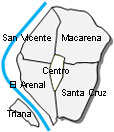 Situated to the southwest of the Iberian Peninsula and towards the west of Andalucía, Seville is the capital and largest city of Andalucía, with a population of approximately 700,000. The city lies in the plain of the Guadalquivir River at just 7 metres above sea level. The river bisects the city and has played a fundamental part in its history.
Situated to the southwest of the Iberian Peninsula and towards the west of Andalucía, Seville is the capital and largest city of Andalucía, with a population of approximately 700,000. The city lies in the plain of the Guadalquivir River at just 7 metres above sea level. The river bisects the city and has played a fundamental part in its history.
Seville is today an extremely lively city faithful to old traditions which are inherent in the life of the city - particularly in the sphere of religion. The historic centre comes to a virtual stand-still at Easter, and throughout the year there are religious festivals including the famous pilgrimage to El Rocio. But there is also a sense of investment in the future. Particularly since the World Expo in 1992, which Seville hosted, the city saw major improvements in both culture - with the building of new theatres, for example - and infrastructure.
Seville has a rich historical legacy,and the Conjunto Monumental - or group of sites - of the Cathedral, Alcázar Royal Palace and the Archivo General de las Indias achieved UNESCO World Heritage status in 1987. This together with a Mediterranean climate and its welcoming and friendly character, make Seville one of the most popular destinations in Spain.
The historic centre of Seville is divided into 6 major neighbourhoods.
El Centro, or the Centre - including the City Hall, Fine Arts Museum, and the famous pedestrianised main shopping streets Sierpes and Tetuan. Here you'll find the commercial heart of the historic centre of the city.
Santa Cruz, famous for its picturesque squares and narrow streets, with the Alcazar Royal Palace and the Cathedral on the doorstep.
El Arenal, home to the iconic Maestranza bullring which gives its name to the neighbourhood, as it refers to the yellow sand in the arena.
Macarena, which is less touristy though possibly today the most authentic neighbourhood of Seville.
San Vicente, the residential neighbourhood between the Guadalquivir River and the Alameda de Hercules, which includes many monasteries, convents and the famous Basilica del Gran Poder.
Triana, technically outside the historic centre, though today considered a part of it, on the left side of the river. Triana is the traditional home of ceramics and flamenco in the city.
Famed for its wonderful spring and autumn time weather and extremely hot summers, Seville has a Mediterranean climate with medium to high temperatures and strong oceanic influences.
The average temperature in spring is around 20-23º C, and winter lows do not normally fall below 12 or 13º C. Rainfall is scant.
The city's climate shows little variation throughout the year, with mild winters and hot summers, with maximum temperatures of 45 degrees.
The average annual temperature is between 16 and 18º C, although the summertime average is a much higher at 27º C.